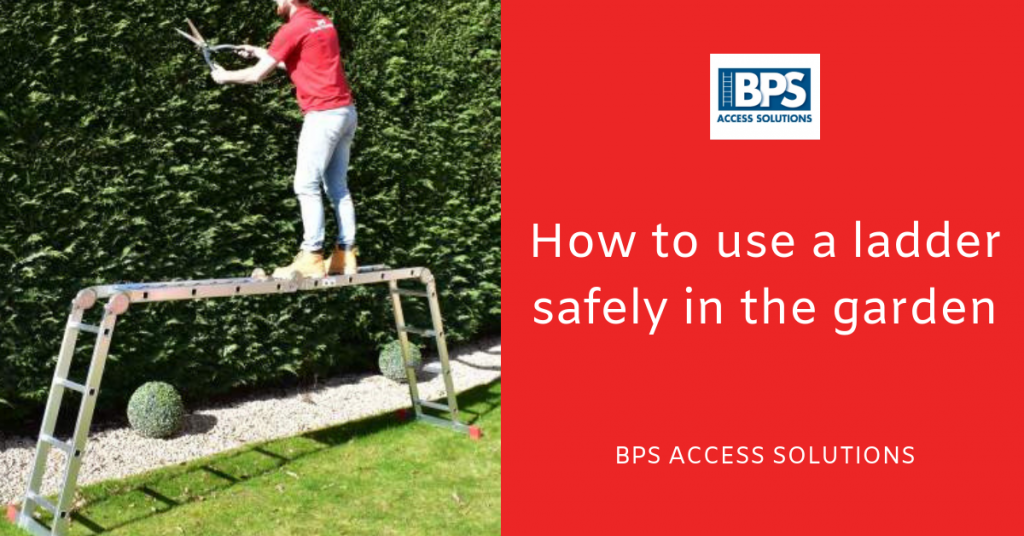How to safely use a ladder in the garden
When using any type of ladder outdoors it is important to do so as shown in the instructions. Climbing a ladder outdoors comes with greater risks and will often be done at greater heights. As a result, there are a number of necessary safety measures and protections which must be kept in mind. Below is a selection of essential safety tips to remember when using a ladder outdoors.
Universal ladder stand
A universal ladder stand is designed to secure your ladder to the structure it is climbing to provide extra stability to the ladder and user. The angled groove found on the ladder stand allows it to be used on a flat surface, such as a wall or a corner. When used with a ladder stand, a ladder can be climbed with a much smaller chance of injury from the ladder unexpectedly coming loose.
Step Platform
Step platforms are secured to the rungs of a ladder to increase the standing area. They allow for greater user maneuverability and balance, all whilst providing added reassurance. Step platforms are easy to attach and can be removed when not needed.
Roof Hooks
Roof hooks are added to the top of ladders and hook over the pitch of a roof to prevent the ladder from slipping, ensuring that the climber has steady and stable support. These ladders are also able to be used on other surfaces and structures to provide the same level of stability.
Wall Pads
Wall pads are placed over the top of the ladder legs, where they can rest against the climbing structure to improve friction and reduce potential slips. Not only do wall pads improve grip, they also protect the surface the ladder is leaning against. Wall pads are similar to the feet at the bottom end of the ladder and both provide increased safety.
Levelling Mat
A levelling mat is placed under both legs of a ladder to provide a single, level surface for the ladder to rest on. This reduces the risk of the ladder becoming unstable or wobbling on uneven ground. Uneven resting surfaces are a commonly overlooked hazard, especially when working outdoors.
Grass/Decking Gripper
The addition of a grass/decking gripper provides a backstop to the ladder legs, preventing them from slipping away from the climbing structure and endangering the user. This attachment is often used on potentially hazardous surfaces, such as grass or decking, which may look stable but could be slippery or wet. Without a grass or decking gripper a loaded ladder could damage or indent the surface it is placed upon.
Ladder Handrail
Handrails are often featured on multipurpose ladders which are used in a variety of different applications. The addition of a handrail provides an extra level of safety, should the user lose their balance or begin to fall backwards. Handrails are a simple yet effective way to decrease the risk of accident to the user.
Ladder Inspection Kit
A ladder inspection kit is used to ensure that a ladder is in safe working order before being put into action. Inspection kits are an essential piece of equipment which allow any ladder to be assessed for safety and usability. They provide guidance for checking a ladder for damaged or missing pieces before use.
Replacement ladder feet
Because it is strongly advised that you only use a ladder if its feet are in working order, you should always have replacement ladder feet on hand in case the existing feet are damaged or broken. Without suitable feet, ladders become much more unsafe and the risk or injury is greatly increased.
Protective Rubber Foot
Placed on the bottom of the ladder legs, protective rubber feet provide extra support and grip, preventing the ladder from becoming unstable. This is especially important on uneven or slippery surfaces.
Alongside the precautions already mentioned, you should always prepare yourself and those around you with necessary measures to ensure safety when working with ladders. This includes use of helmets and other suitable clothing, such as gloves and boots, and could even extend to use of a harness when climbing especially tall ladders.
Always avoid using a ladder in bad weather and make sure you keep three points of contact with the ladder at all times to maximise control and balance. Know your limits and never overreach or overbalance yourself as this will greatly increase the risk of accident or injury. Following these simple precautions will allow you to use ladders as safely and efficiently as possible.
For more information about ladder safety or to find out about our range of ladders and other equipment, contact BPS Solutions today. Our expertise has been built over many years of using and understanding these products.
No related posts.



